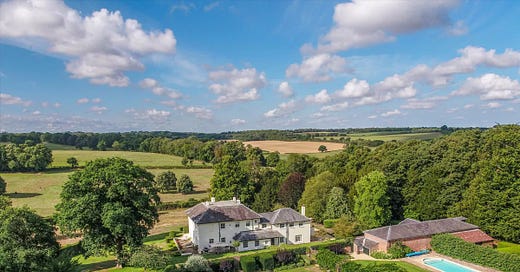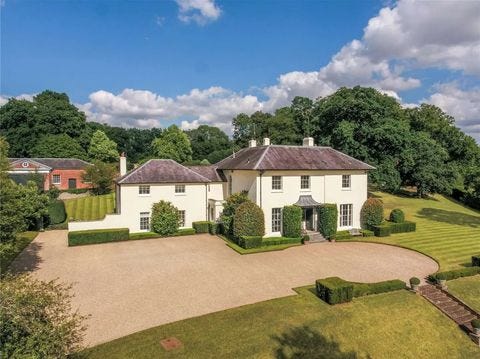For Sale: £8.5 million Georgian home at Steventon, the birthplace of Jane Austen
You could be livin' it up like Jane Austen.

In early May 1801, Jane Austen removed from her home of 25 years at Steventon, Basingstoke, Hampshire, to Bath, where her father, Rev. George Austen, chose to retire. Much like Anne Elliot in Persuasion, a novel she had yet to write, Jane wasn’t excited about the move (news her father surprised her with on her birthday, Dec. 16th, 1800). In a letter she wrote to Cassandra from Bath—Jane & their mother arrived before Cassandra & Rev. Austen—Austen tries to be thrilled with the situation: “I have the pleasure of writing from my own room up two pair of stairs, with everything comfortable about me”1 (Letter 35). At Steventon, she shared a room with Cassandra, & the rectory would have been crowded with eight children. But the home Jane writes this letter from isn’t permanent; she & Mrs. Austen stay with Aunt & Uncle Leigh-Perrot, who are helping the family house hunt. “When my Uncle went to take his second glass of water, I walked with him & in our morning’s circuit we looked at two Houses in Green Park Buildings, one of which pleased me very well,” Jane writes in her letter to Cassandra.
Leaving Steventon must have been hard for Jane for reasons other than it was the only home she knew; it was where she developed as a writer by reading from her father’s 500-volume library (books that needed to be sold, according to a letter Jane writes to Cassandra in February 1801), & where she penned S & S, P & P, & Northanger Abbey (though these early drafts would have gone by Elinor & Marianne, First Impressions, & Susan). In a letter Jane sent from Steventon to Godmersham where Cassandra was staying in January 1799, she mentions First Impressions: “I do not wonder at your wanting to read first impressions again, so seldom as you have gone through it, & that so long ago” (Letter 17). This suggests that Austen was sharing drafts of what would one day be P & P with her family while at Steventon.
Jane & her novels are certainly the headline of every article & listing for this 6,900 square-foot Georgian house with six bedrooms, an outdoor swimming pool, & a tennis court that now stands on the Steventon property. The Knight Frank website even lists “birth place of Jane Austen” as one of the amenities:

Not that Jane would have recognized this modern luxury home; nothing of the rectory she grew up in still exists. Though for adoring Janeites who have the means (the listing price is £8.5 million), it could be nice to imagine becoming a modern incarnation of Austen while lounging by the outdoor swimming pool.
While lacking the modern luxuries of a tennis court & fully-equipped kitchen, the Austen’s home at Steventon wasn’t too shabby, boasting seven bedrooms, three sitting-rooms, & two attics.2 In Lucy Worsley’s documentary Jane Austen: Behind Closed Doors, she conjures up the floor plan of the family home with the help of archaeologist Debbie Charlton. Together, they identify sections of the house such as the lobby, a front & back kitchen, two parlors, & Rev. Austen’s study looking out on a cucumber garden at the back of the house.

But a description of the interior from Anna Austen Lefroy, Jane Austen’s niece, also survives, providing us with the clearest picture of the Austen family home:
“The dining or common sitting-room looked to the front & was lighted by two casement windows. On the same side, a front door opened into a smaller parlour, & visitors, who were few & rare, were not a bit less welcome to my grandmother because they found her there busily engaged with her needle, making & mending. In later times…a sitting-room was made upstairs: ‘the dressing room,’ as they were pleased to call it, perhaps because it opened into a smaller chamber in which my two aunts slept. I remember the common looking carpet with its chocolate ground, & painted press with shelves above for books, & Jane’s piano, & an oval looking-glass that hung between the windows; but the charm of the room with its scanty furniture & cheaply painted walls must have been, for those old enough to understand it, the flow of native wit with all the fun of a large & clever family.” 3
The “scanty furniture,” “cheaply painted walls,” & “common looking carpet”—Anna Lefroy clearly missed her calling as a real estate agent. But, of course, she wasn’t looking to write an Instagram caption for an image of a stately home; she’s remembering a house she loved dearly & the “large & clever family” who occupied it. It is they, she writes, who gave the house its “charm.” Walking the 50 acres of woodland & gardens, you can imagine Jane Austen walking those same paths, but to look back at the updated Georgian manor…can we so easily place Austen in it?
The provenance of the Steventon estate is important for understanding how the Austen’s acquired it & the history of the house that now stands on the property. In her book Jane Austen’s Steventon (2007), Deirdre Le Faye traces the history of the houses from a Norman Manor built around 1185 to the Tudor farmhouse occupied by the Digweed family, who are mentioned by Austen in her surviving letters, at the end of the 18th century. In 1761, Rev. George Austen’s wealthy relative, Thomas Knight, gave him the living at Steventon. Since Knight & his wife were childless, they adopted Jane’s brother Edward as their legal heir, & he inherited Steventon upon Knight’s death in 1794. After the family left, the rectory was demolished in the mid-19th century & a new one was built for Edward Knight’s son, William Knight, who became the rector. A lime tree planted by James Austen in 1813 is all there is to help visitors find the location of Jane’s first home.4
So what you can get for £8.5 million is a beautiful Georgian manor house, with all its modern amenities, that’s in the vicinity of where Jane Austen spent 25 years of her life. You can still see nearby St. Nicholas’s Church, where Rev. Austen was rector. You can still walk the same paths Jane followed to pay calls & take in the country air. But you can’t sit & write your novel where Austen would have written P & P. A sign that, perhaps, the genius Austen brought us could only happen once.
From the comments on Instagram, it doesn’t seem like many people even care that Jane Austen grew up on the property—it’s just a picture of a pretty house for sale on a page with lots of pictures of pretty houses for sale.
One commenter thinks Jane Austen wrote Middlemarch. No one has told them that it was George Eliot.
Le Faye, D. (Ed.) (2011). Jane Austen’s Letters (4th edition). Oxford University Press.
Walton, Geri. (2019, May 20). “Jane Austen’s Steventon and Her Life There.” Geri Walton: Unique Histories from the 18th and 19th centuries. https://www.geriwalton.com/jane-austens-steventon-and-her-life-there/#_ftn3
Odiwe, J. (2013, April 25). “Jane Austen’s China and the Steventon Dig!” Historical and Regency Romance UK. http://historicalromanceuk.blogspot.com/2013/04/
Morton, A. (2020). “Finding Steventon: Jane Austen’s Home.” Thither: Costuming and resources for lovers of the work and world of Jane Austen. https://www.thitherjaneausten.com/finding-steventon-jane-austens-home





